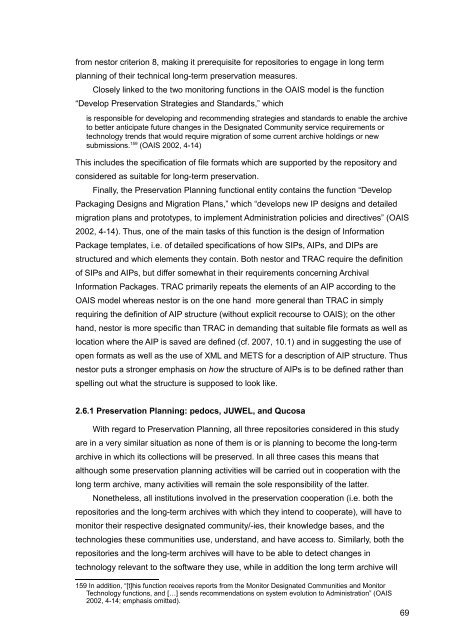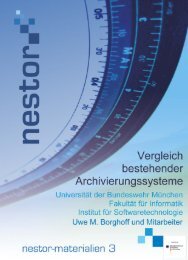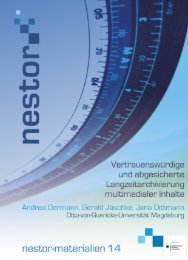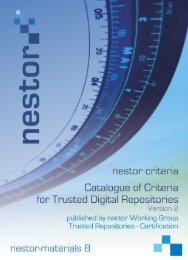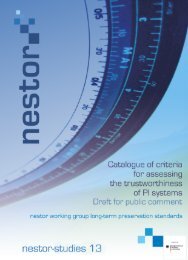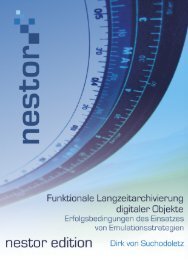Download (PDF, 9MB, Not barrier-free file.) - Nestor
Download (PDF, 9MB, Not barrier-free file.) - Nestor
Download (PDF, 9MB, Not barrier-free file.) - Nestor
- No tags were found...
You also want an ePaper? Increase the reach of your titles
YUMPU automatically turns print PDFs into web optimized ePapers that Google loves.
from nestor criterion 8, making it prerequisite for repositories to engage in long termplanning of their technical long-term preservation measures.Closely linked to the two monitoring functions in the OAIS model is the function“Develop Preservation Strategies and Standards,” whichis responsible for developing and recommending strategies and standards to enable the archiveto better anticipate future changes in the Designated Community service requirements ortechnology trends that would require migration of some current archive holdings or newsubmissions. 159 (OAIS 2002, 4-14)This includes the specification of <strong>file</strong> formats which are supported by the repository andconsidered as suitable for long-term preservation.Finally, the Preservation Planning functional entity contains the function “DevelopPackaging Designs and Migration Plans,” which “develops new IP designs and detailedmigration plans and prototypes, to implement Administration policies and directives” (OAIS2002, 4-14). Thus, one of the main tasks of this function is the design of InformationPackage templates, i.e. of detailed specifications of how SIPs, AIPs, and DIPs arestructured and which elements they contain. Both nestor and TRAC require the definitionof SIPs and AIPs, but differ somewhat in their requirements concerning ArchivalInformation Packages. TRAC primarily repeats the elements of an AIP according to theOAIS model whereas nestor is on the one hand more general than TRAC in simplyrequiring the definition of AIP structure (without explicit recourse to OAIS); on the otherhand, nestor is more specific than TRAC in demanding that suitable <strong>file</strong> formats as well aslocation where the AIP is saved are defined (cf. 2007, 10.1) and in suggesting the use ofopen formats as well as the use of XML and METS for a description of AIP structure. Thusnestor puts a stronger emphasis on how the structure of AIPs is to be defined rather thanspelling out what the structure is supposed to look like.2.6.1 Preservation Planning: pedocs, JUWEL, and QucosaWith regard to Preservation Planning, all three repositories considered in this studyare in a very similar situation as none of them is or is planning to become the long-termarchive in which its collections will be preserved. In all three cases this means thatalthough some preservation planning activities will be carried out in cooperation with thelong term archive, many activities will remain the sole responsibility of the latter.Nonetheless, all institutions involved in the preservation cooperation (i.e. both therepositories and the long-term archives with which they intend to cooperate), will have tomonitor their respective designated community/-ies, their knowledge bases, and thetechnologies these communities use, understand, and have access to. Similarly, both therepositories and the long-term archives will have to be able to detect changes intechnology relevant to the software they use, while in addition the long term archive will159 In addition, “[t]his function receives reports from the Monitor Designated Communities and MonitorTechnology functions, and […] sends recommendations on system evolution to Administration” (OAIS2002, 4-14; emphasis omitted).69


